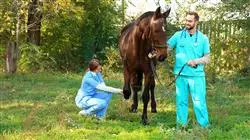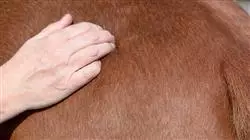University certificate
The world's largest faculty of physiotherapy”
Introduction to the Program
Physiotherapists specialized in the treatment of equines will achieve great benefits in the rehabilitation of these animals if they update their knowledge with this very complete program"

Sports injuries in horses, as well as other pathologies such as lameness or those related to the advanced age of these animals, require rehabilitation to achieve effective recoveries and the possible readaptation of the animal to exercise.
The Professional master’s degree in Equine Rehabilitation approaches this discipline from the experience of several internationally accredited rehabilitation specialists, as well as the scientific analysis on rehabilitation seen in a global way, including information that cannot be found in any other online or classroom program, with a teaching staff of the highest level.
The contents of this preparatory program are based on experience, scientific evidence and practical application. The objective is that the student is able to develop rehabilitation plans and physiotherapy treatments, with a solid foundation that gives the maximum guarantee of success, both in planning and execution.
In this way, this program provides students with specialized tools and skills to successfully develop their professional activity in the wide environment of equine rehabilitation, working on key competencies such as knowledge of the reality and daily practice of the physiotherapist, and developing responsibility in the monitoring and supervision of their work, as well as communication skills within the essential teamwork.
As it is an online program, students will not be bound by fixed schedules or the need to move to another physical location, but rather, they can access the content at any time of the day, balancing their professional or personal life with their academic life.
Do not miss the opportunity to do this Professional Master’s Degree in Equine Rehabilitation with us. It's the perfect opportunity to advance your career"
This Professional master’s degree in Equine Rehabilitation contains the most complete and up-to-date educational program on the market. The most outstanding characteristics of this program are:
- The development of practical cases presented by experts in Equine Rehabilitation
- The graphic, schematic, and practical contents with which they are created provide scientific and practical information on the disciplines that are essential for professional development
- Latest developments in equine rehabilitation
- Practical exercises where self-assessment can be used to improve learning
- Special emphasis on innovative methodologies in equine rehabilitation
- Theoretical lessons, questions to the expert, debate forums on controversial topics, and individual reflection assignments
- Content that is accessible from any fixed or portable device with an internet connection
This program is the best investment you can make when selecting a refresher program to update your knowledge in Equine Rehabilitation"
It includes in its teaching staff professionals belonging to the field of Physiotherapy, who bring to this training the experience of their work, as well as recognized specialists from reference societies and prestigious universities.
The multimedia content, developed with the latest educational technology, will provide the professional with situated and contextual learning, i.e., a simulated environment that will provide immersive learning programmed to train in real situations.
This program is designed around Problem-Based Learning, whereby the specialist must try to solve the different professional practice situations that arise throughout the program. For this purpose, the professional will be assisted by an innovative interactive video system developed by renowned and experienced experts in Equine Rehabilitation.
This program comes with the best teaching material, providing you with a contextual approach that will facilitate your learning"

This 100% online program will allow you to combine your studies with your professional work while increasing your knowledge in this field"
Why study at TECH?
TECH is the world’s largest online university. With an impressive catalog of more than 14,000 university programs available in 11 languages, it is positioned as a leader in employability, with a 99% job placement rate. In addition, it relies on an enormous faculty of more than 6,000 professors of the highest international renown.

Study at the world's largest online university and guarantee your professional success. The future starts at TECH”
The world’s best online university according to FORBES
The prestigious Forbes magazine, specialized in business and finance, has highlighted TECH as “the world's best online university” This is what they have recently stated in an article in their digital edition in which they echo the success story of this institution, “thanks to the academic offer it provides, the selection of its teaching staff, and an innovative learning method aimed at educating the professionals of the future”
A revolutionary study method, a cutting-edge faculty and a practical focus: the key to TECH's success.
The most complete study plans on the university scene
TECH offers the most complete study plans on the university scene, with syllabuses that cover fundamental concepts and, at the same time, the main scientific advances in their specific scientific areas. In addition, these programs are continuously being updated to guarantee students the academic vanguard and the most in-demand professional skills. In this way, the university's qualifications provide its graduates with a significant advantage to propel their careers to success.
TECH offers the most comprehensive and intensive study plans on the current university scene.
A world-class teaching staff
TECH's teaching staff is made up of more than 6,000 professors with the highest international recognition. Professors, researchers and top executives of multinational companies, including Isaiah Covington, performance coach of the Boston Celtics; Magda Romanska, principal investigator at Harvard MetaLAB; Ignacio Wistumba, chairman of the department of translational molecular pathology at MD Anderson Cancer Center; and D.W. Pine, creative director of TIME magazine, among others.
Internationally renowned experts, specialized in different branches of Health, Technology, Communication and Business, form part of the TECH faculty.
A unique learning method
TECH is the first university to use Relearning in all its programs. It is the best online learning methodology, accredited with international teaching quality certifications, provided by prestigious educational agencies. In addition, this disruptive educational model is complemented with the “Case Method”, thereby setting up a unique online teaching strategy. Innovative teaching resources are also implemented, including detailed videos, infographics and interactive summaries.
TECH combines Relearning and the Case Method in all its university programs to guarantee excellent theoretical and practical learning, studying whenever and wherever you want.
The world's largest online university
TECH is the world’s largest online university. We are the largest educational institution, with the best and widest online educational catalog, one hundred percent online and covering the vast majority of areas of knowledge. We offer a large selection of our own degrees and accredited online undergraduate and postgraduate degrees. In total, more than 14,000 university degrees, in eleven different languages, make us the largest educational largest in the world.
TECH has the world's most extensive catalog of academic and official programs, available in more than 11 languages.
Google Premier Partner
The American technology giant has awarded TECH the Google Google Premier Partner badge. This award, which is only available to 3% of the world's companies, highlights the efficient, flexible and tailored experience that this university provides to students. The recognition as a Google Premier Partner not only accredits the maximum rigor, performance and investment in TECH's digital infrastructures, but also places this university as one of the world's leading technology companies.
Google has positioned TECH in the top 3% of the world's most important technology companies by awarding it its Google Premier Partner badge.
The official online university of the NBA
TECH is the official online university of the NBA. Thanks to our agreement with the biggest league in basketball, we offer our students exclusive university programs, as well as a wide variety of educational resources focused on the business of the league and other areas of the sports industry. Each program is made up of a uniquely designed syllabus and features exceptional guest hosts: professionals with a distinguished sports background who will offer their expertise on the most relevant topics.
TECH has been selected by the NBA, the world's top basketball league, as its official online university.
The top-rated university by its students
Students have positioned TECH as the world's top-rated university on the main review websites, with a highest rating of 4.9 out of 5, obtained from more than 1,000 reviews. These results consolidate TECH as the benchmark university institution at an international level, reflecting the excellence and positive impact of its educational model.” reflecting the excellence and positive impact of its educational model.”
TECH is the world’s top-rated university by its students.
Leaders in employability
TECH has managed to become the leading university in employability. 99% of its students obtain jobs in the academic field they have studied, within one year of completing any of the university's programs. A similar number achieve immediate career enhancement. All this thanks to a study methodology that bases its effectiveness on the acquisition of practical skills, which are absolutely necessary for professional development.
99% of TECH graduates find a job within a year of completing their studies.
Professional Master's Degree in Equine Rehabilitation
Do horses have any relation with physiotherapy? Consider the following scenario: a rider slips with his mount during an equestrian race and suffers a fibrillar rupture. As physiotherapeutic treatment is a fundamental component in the recovery of sports injuries, appropriate care is provided. It happens that the equine specimen has also suffered a locomotor condition in one of the suspensory ligaments. Is it possible to use the same therapeutic principles to help the animal? Yes, and the Professional Master's Degree in Equine Rehabilitation at TECH Global University teaches you how to do it. Supported by a high-level teaching staff, an extraordinary cognitive immersion software and the most complete curriculum, we offer you a unique professional growth opportunity where you can manage your own schedule and access even from the comfort of a smartphone connected to the internet. Not only will you learn about the anatomical, physiological and biomechanical conditions unique to horses, we will instruct you in specialized knowledge such as analgesic electrotherapy and ultrasound: everything to take your career to the next level.
Get your online program in equine rehabilitation physiotherapy
Movement is the basic pillar of physiotherapy; we analyze the joints and muscles involved in the various kinetic actions, as well as the environment in which they take place to define the best physical rehabilitation technique. In an area such as equestrian sports, we are not only talking about the musculoskeletal system of the person but also of the animal that rides. Horses move distributing the weight and force in their four limbs, therefore, a single injury can affect both lower tendons and the cervical area. The Professional Master's Degree we offer is an excellent academic alternative to train you solidly in the area of equine medicine and thus broaden your career horizons. Throughout ten modules we will teach you about topics such as therapeutic exercise and active kinesitherapy, diagnostic imaging, common pathologies in sport horses, among others. Do you want to acquire a program that will positively transform your future without leaving home? Enroll in TECH.







